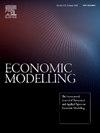Sectoral exposure and its impact on bank risk: Evidence from India
IF 4.7
2区 经济学
Q1 ECONOMICS
引用次数: 0
Abstract
This study investigates how banks’ sectoral loan exposures affect their risk profiles. We introduce two market-derived measures: Aggregate diversification, which gauges vulnerability to sector-specific shocks, and Differential specialization, indicating how much a bank’s sectoral focus diverges from industry average. Analyzing data from 2006 to 2022 for Indian commercial banks, we find that greater aggregate diversification significantly reduces bank risk, while higher differential specialization increases it. Specifically, a one standard deviation increase in Aggregate diversification improves bank stability by 3.4%, whereas a comparable increase in Differential specialization reduces stability by 7.2%. The stabilizing effect of diversification stems from reduced stock volatility, lower financing costs, and enhanced market valuations. Specialization conversely correlates with higher non-performing loans and diminished shareholder value. These results emphasize the importance of employing high-frequency return data to measure risk and underscore the sectoral context and institutional capacity in shaping the risk-return trade-offs between diversification and specialization.
行业风险敞口及其对银行风险的影响:来自印度的证据
本研究调查了银行的部门贷款敞口如何影响其风险概况。我们引入了两种源自市场的衡量指标:总体多元化,衡量对特定行业冲击的脆弱性;差异化专业化,表明银行对行业的关注与行业平均水平的偏离程度。通过对印度商业银行2006 - 2022年数据的分析,我们发现,总体多元化程度越高,银行风险就越低,而差异专业化程度越高,银行风险就越高。具体而言,总体多样化增加一个标准差可使银行稳定性提高3.4%,而差异性专业化的可比增加则会使稳定性降低7.2%。多元化的稳定效应源于降低股票波动、降低融资成本和提高市场估值。专业化与更高的不良贷款和减少的股东价值相反相关。这些结果强调了采用高频回报数据来衡量风险的重要性,并强调了部门背景和机构能力在形成多样化和专业化之间的风险-回报权衡方面的重要性。
本文章由计算机程序翻译,如有差异,请以英文原文为准。
求助全文
约1分钟内获得全文
求助全文
来源期刊

Economic Modelling
ECONOMICS-
CiteScore
8.00
自引率
10.60%
发文量
295
期刊介绍:
Economic Modelling fills a major gap in the economics literature, providing a single source of both theoretical and applied papers on economic modelling. The journal prime objective is to provide an international review of the state-of-the-art in economic modelling. Economic Modelling publishes the complete versions of many large-scale models of industrially advanced economies which have been developed for policy analysis. Examples are the Bank of England Model and the US Federal Reserve Board Model which had hitherto been unpublished. As individual models are revised and updated, the journal publishes subsequent papers dealing with these revisions, so keeping its readers as up to date as possible.
 求助内容:
求助内容: 应助结果提醒方式:
应助结果提醒方式:


